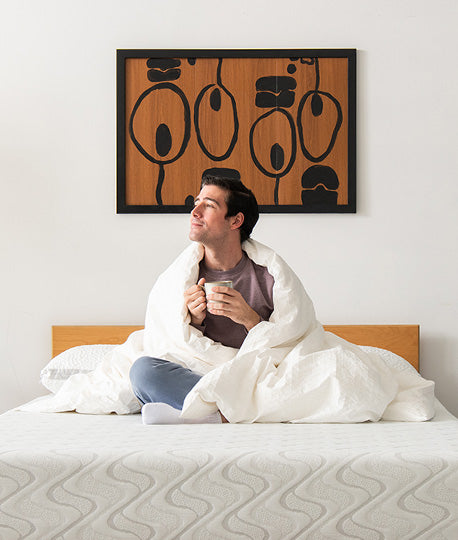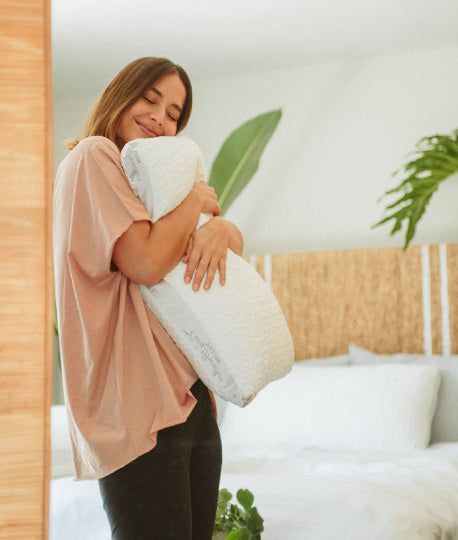Relaxation Techniques: How To Relax Before Bed For Better Sleep

Getting quality sleep starts with learning how to truly unwind. 30-40% of adults experience insomnia symptoms each year, which makes having a solid wind-down routine more important than ever. The good news? Simple, proven techniques can calm your mind, relax your body, and help you ease into a restful night.
Breathing exercises, meditation, and progressive muscle relaxation all support better sleep, especially when paired with a cozy, well-designed sleep setup. Together, they create the ideal environment for falling asleep naturally and waking up refreshed.
The Science Behind Pre-Bedtime Relaxation
Falling asleep isn’t just about feeling tired. It’s about helping your body shift into rest mode. Relaxation techniques play a key role by activating the parasympathetic nervous system, often called the “rest and digest” system. At the same time, they calm the sympathetic nervous system, which is responsible for the fight-or-flight response. As your body shifts, your heart rate slows, blood pressure drops, muscles relax, and breathing becomes steadier, all of which help you fall asleep more easily.
Studies show that regular pre-bed relaxation practices can shorten the time it takes to fall asleep and lead to deeper, more restful sleep. When combined with good sleep habits and a supportive mattress like our Owl Natural Hybrid Latex mattress, these techniques can make a noticeable difference in how you feel each morning.
Breathing Exercises for Better Sleep
One of the easiest ways to relax before bed is through controlled breathing. A simple technique called belly breathing, or diaphragmatic breathing, can help calm your nervous system and prepare your body for rest.
To try it, lie on your back in a comfortable position. A supportive mattress can make it easier to stay aligned and relaxed. Place one hand on your chest and the other on your belly. Breathe in slowly through your nose. You should feel your belly rise while your chest stays mostly still. Then exhale gently through slightly pursed lips. Continue this pattern for 5 to 10 minutes, letting each breath help you settle in for the night.
The 4-7-8 breathing method is another simple technique that can help you wind down. Developed by Dr. Andrew Weil, this pattern is designed to calm the nervous system and ease your body into a restful state. While lying in bed, breathe in quietly through your nose for 4 seconds, hold that breath for 7 seconds, then slowly exhale through your mouth for 8 seconds. Start with four rounds and increase to eight as you get more comfortable.
Studies show that regular breathing exercises like this one can lower pre-sleep anxiety. The key is making it part of your nightly routine. With just a few minutes of practice each night, you can create a smoother transition into sleep.
Progressive Muscle Relaxation: A Full-Body Approach
Progressive muscle relaxation, or PMR, is a simple way to release tension in your body before bed. It’s especially helpful when done on a pressure-relieving surface like our Sparrow Signature Hybrid mattress, which helps keep your body comfortably aligned as you go through the steps.
To try it, lie on your back in a relaxed position. Start at your toes. Gently tense the muscles for about 5 to 10 seconds, then fully release for 15 to 20 seconds. Notice how it feels to let go of that tension. Slowly move up through each part of your body: feet, calves, thighs, hips, stomach, chest, arms, hands, neck, and face.
Research published in Frontiers in Psychology found that people who practiced PMR had fewer nighttime wake-ups and felt more refreshed in the morning. This technique helps you become more aware of the tension you’re holding onto and teaches your body how to let it go—one area at a time.
Meditation Techniques for Sleep
Mindfulness meditation has become a go-to tool for better sleep, and there’s plenty of research to back it up. People who practice mindfulness regularly report fewer sleep troubles, less fatigue, and even lower levels of stress and anxiety compared to those who follow standard sleep tips alone.
One helpful method to try at bedtime is a body scan meditation. While lying comfortably, ideally on a mattress that supports your natural alignment, slowly bring your attention to different parts of your body. Start at your toes and move upward to the top of your head, spending 15 to 30 seconds on each area. Just notice what you feel, without trying to change anything.
Another great option is visualization. Picture a peaceful place, like a quiet beach or a calm forest. Try to involve all your senses. What do you see? What can you hear or smell? This simple practice can help shift your focus away from daily stress and guide your body into a more relaxed state.
Creating the Optimal Sleep Environment
The effectiveness of relaxation techniques multiplies when you practice them in the right environment. Temperature, light, sound, and comfort all play crucial roles in preparing for sleep. Cleveland Clinic recommends keeping bedroom temperature between 60-67°F (15-19°C) for optimal sleep conditions.
Your mattress also makes a big difference. A supportive, pressure-relieving surface helps your body fully relax during techniques like breathing exercises or meditation. Our collection of natural and sustainable mattresses provides the ideal foundation for relaxation practices. The Finch Natural Latex mattress, for example, offers targeted pressure relief while maintaining proper spinal alignment - essential for both comfort and the effectiveness of relaxation techniques.
Quality bedding also contributes to the relaxation process. Our organic cotton sheets and pillowcases provide breathable comfort that helps regulate body temperature, while our weighted blankets offer gentle pressure that research shows can reduce anxiety and promote relaxation.
Sound Therapy and Other Sleep Aids
While not relaxation techniques on their own, certain tools can make your bedtime routine even more effective. White noise and nature sounds help block out distractions and create a calm, consistent background. Research shows that using white noise can shorten the time it takes to fall asleep by as much as 38 percent.
Brain wave music is another helpful option. These soundtracks are designed to mirror your brain’s natural sleep rhythms and often include binaural beats—two slightly different tones played in each ear. Studies suggest that this type of sound can support relaxation and make it easier to drift off.
Establishing a Consistent Routine
The secret to getting the most out of these relaxation techniques is consistency. Try building a regular bedtime routine that includes the methods that work best for you. Start winding down about 30 to 60 minutes before bed by dimming the lights and stepping away from screens. Then, ease into your breathing exercises or meditation while lying comfortably on your Nest Bedding mattress.
It can help to track your progress with a simple sleep diary for the first couple of weeks. Make note of which techniques feel most effective and any changes you notice in your sleep quality. Keep in mind that improvement takes time. Give each method at least two weeks before deciding how well it’s working for you.
Conclusion
Relaxing before bed works best when you combine proven techniques with the right sleep environment. Start by choosing one or two methods that feel right for you. You might pair breathing exercises with progressive muscle relaxation, for example. Practice them regularly, and make sure your sleep setup helps your body relax. Our natural mattresses and organic bedding are designed to create a calm, comfortable foundation for your routine.
Improving sleep takes time. Be patient with yourself as you build these new habits. With consistency and the right tools, you'll be on your way to deeper, more restful sleep. If sleep issues continue even after sticking with your routine, it may be time to talk with a healthcare provider for personalized support.




